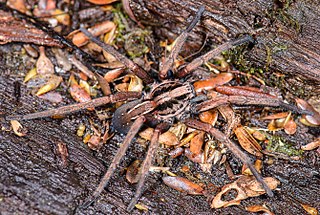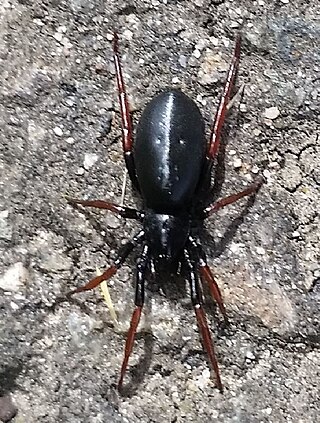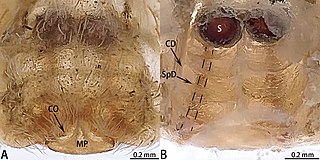
Miturgidae is a family of araneomorph spiders that includes nearly 170 species in 29 genera worldwide. First described by Eugène Simon in 1886, it has been substantially revised, and includes the previous family Zoridae as a synonym, and excludes the family Xenoctenidae. Several genera have also been removed, such as the large genus Cheiracanthium, which was transferred to the Cheiracanthiidae.

Liocranidae is a family of araneomorph spiders first described by Eugène Simon in 1897. They are one of several groups called "sac spiders". The holarctic genus Agroeca is the best-known, but it also includes various genera of more obscure spiders that still lack a diagnosis. Two species in the North American genus Neoanagraphis are found in the extremely dry conditions in the Mojave, Sonoran and Chihuahuan deserts. Females live in animal burrows while males wander and are the ones most often caught in pitfall traps.

Euophrys is a genus of jumping spiders that was first described by Carl Ludwig Koch in 1834. The small black E. omnisuperstes lives on Mount Everest at elevations up to 6,700 meters, possibly making it the most elevated animal in the world.

Evarcha is a genus of spiders in the family Salticidae with 85 species distributed across the world.

Icius is a genus of jumping spiders described by Eugène Simon in 1876, belonging to the Order Araneae, Family Salticidae.

Plexippus is a genus of jumping spiders that was first described by Carl Ludwig Koch in 1846. It is considered a senior synonym of Hissarinus and Apamamia.

Cheiracanthium, commonly called yellow sac spiders, is a genus of araneomorph spiders in the family Cheiracanthiidae, and was first described by Carl Ludwig Koch in 1839. They are usually pale in colour, and have an abdomen that can range from yellow to beige. Both sexes range in size from 5 to 10 millimetres. They are unique among common house spiders because their tarsi do not point either outward, like members of Tegenaria, or inward, like members of Araneus), making them easier to identify.

Agroeca is a genus of liocranid sac spiders that was first described by Niklas Westring in 1861.

Oxyopes is a genus of lynx spiders found worldwide. It includes arounds 300 species and is classified under the lynx spider family Oxyopidae. Like other lynx spiders, they are easily recognizable by the six larger eyes arranged hexagonally on top of the head (prosoma), with the remaining smaller two eyes in front. They are also characterized by long spine-like bristles (setae) on their legs. They are ambush predators, actively hunting prey by sight. Though they produce and use silk, they do not build webs to capture prey.

Trachelidae is a family of araneomorph spiders first described by Eugène Simon in 1897 as a subfamily called "Tracheleae". The Trachelidae family, also known as "ground sac spiders", is within the group of spiders known as the RTA clade, which includes mostly wandering spiders that do not use webs. Spiders in the Trachelidae family are characterized as being 3-10mm long and having a red cephalothorax and a yellow/tan abdomen. They are commonly found indoors. It was placed in the family Clubionidae, then later in Corinnidae when the Clubionidae were split up. The first study that suggested Trachelidae should be considered its own family was done by Deeleman-reinhold in 2001 as part of an analysis of RTA Clade spiders. An analysis by Martín J. Ramírez in 2014 suggested that it was not closely related to other members of the Corinnidae, and was better treated as a separate family. It was then placed in the CTC clade of spiders, or the Claw Tuft Clasper clade, which is a group of spiders that have two tarsal claws with tufts of hair.

Scotophaeus is a genus of ground spiders that was first described by Eugène Simon in 1893.

Aphantaulax is a genus of ground spiders that was first described by Eugène Simon in 1878.

Scotina is a genus of sac spiders of the family Liocranidae which was named by the German zoologist Franz Anton Menge in 1873 with Scotina gracilipes as the type species. Scotina was thought to be a mainly Western Palearctic genus but one species, Scotina palliardi was found in Korea in 2011. The species in the genus Scotina are small spiders which have six to ten pairs of ventral spines which can be seen using a lens. They have a darker and shinier cephalothorax than in other genera within the Liocranidae. They also have light brown femora with the more distal segments of the legs are darker, especially on the first pairs. They are terrestrial spiders which are mainly found among moss and litter on the ground.
Agraecina is a genus of liocranid sac spiders that was first described by Eugène Louis Simon in 1932.
Mesiotelus is a genus of spiders in the family Liocranidae. It was first described in 1897 by Eugène Simon.

Trachyzelotes is a genus of ground spiders that was first described by H. Lohmander in 1944 as a subgenus of Zelotes, and was raised to genus status in 1967. It has a body length of 3 to 13 millimetres.

Phrurolithus is a genus of araneomorph spiders first described by C. L. Koch in 1839. First placed with the Liocranidae, it was moved to the Corinnidae in 2002, then to the Phrurolithidae in 2014.

Asianopis is a genus of Asian net-casting spiders first described by Y. J. Lin, L. Shao and A. Hänggi in 2020.
Marinarozelotes is a genus of ground spiders first described by A. V. Ponomarev and V. Y. Shmatko in 2020. The type species, Marinarozelotes barbatus, was originally described under the name "Melanophora barbata".
Sestakovaia is a small genus of liocranid sac spiders first described by Alireza Zamani and Yuri M. Marusik in 2021. As of December 2021 it contains only two species: S. annulipes and S. hyrcania. This genus is named after the Slovakian arachnologist Anna Šestáková.
















